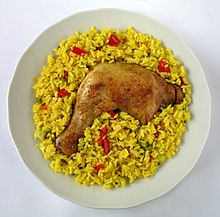Arroz con pollo
 | |
| Place of origin | Spain and Puerto Rico |
|---|---|
| Region or state | Spain, Latin America |
| Main ingredients | rice, chicken, vegetables |

Arroz con pollo (rice with chicken) is a traditional dish of Spain and Latin America, closely related to paella. In the Dominican Republic it is called locrio de pollo, and in Saint Martin it is called lokri or locreo.[1][2][3][4][5]
There is some debate as to whether it originated in Spain. Puerto Ricans consider it one of their classic recipes. Many Puerto Ricans note that arroz con pollo cannot be made without beer and annatto oil and saffron is no substitute. Beer and annatto are rarely used in Spanish cooking and never in arroz con pollo there. Annatto is frequently used in Puerto Rican cooking especially in rice dishes like arroz con gandules (rice with pork and pigeon peas) and arroz con maiz (rice with corn and sausage). Beer is used in many Puerto Rican dishes like pollo guisado (braised stewed chicken) and asopao de pollo (chicken rice stew). Arroz con pollo and most Puerto Rican rice dishes are highly seasoned with sofrito, which is another key ingredient in arroz con pollo.
Food writer Elisabeth Lambert Ortiz, pointing out the international aspects of the dish, notes the origin of Arroz con Pollo in the Spanish forms of pilaf, already reflecting international influences: chicken was brought from India and rice from Asia; saffron (used for the yellow colour in Spain, instead of annatto) was introduced by Phoenician traders; tomatoes and peppers (also known as sofrito) are natives of the Americas.[1][6]
See also
- Arroz caldo
- Biryani
- Cabidela
- Chicken and rice (disambiguation)
- List of chicken dishes
- List of rice dishes
 Food portal
Food portal Latin America portal
Latin America portal
References
- ^ a b Elisabeth Lambert Ortiz (9 September 1998). Cocina latinoamericana. EDAF. p. 251. ISBN 978-84-414-0421-2. Retrieved 9 August 2011.
- ^ Alice L. McLean (30 August 2006). Cooking in America, 1840–1945. Greenwood Publishing Group. p. 139. ISBN 978-0-313-33574-7. Retrieved 8 August 2011.
- ^ Robert M. Weir; Karen Hess (March 1998). The Carolina Rice Kitchen: The African Connection. Univ of South Carolina Press. p. 39. ISBN 978-1-57003-208-0. Retrieved 8 August 2011.
- ^ Kellie Jones; Amiri Baraka; Lisa Jones; Hettie Jones; Guthrie P. Ramsey (6 May 2011). EyeMinded: Living and Writing Contemporary Art. Duke University Press. p. 285. ISBN 978-0-8223-4873-3. Retrieved 8 August 2011.
- ^ D. H. Figueredo (16 July 2002). The complete idiot's guide to Latino history and culture. Penguin. p. 250. ISBN 978-0-02-864360-1. Retrieved 8 August 2011.
- ^ "Arroz con Pollo"/ Foodandwine.com. Accessed August 2011.












